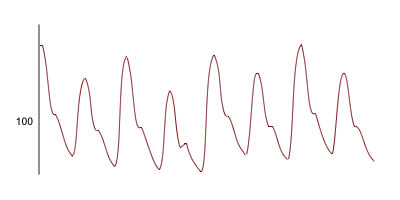Pulsus alternans
Editor-In-Chief: C. Michael Gibson, M.S., M.D. [1]; Associate Editor(s)-in-Chief: Varun Kumar, M.B.B.S.; Mohamed Moubarak, M.D. [2]
Overview
Pulsus alternans is a physical finding with arterial pulse waveform showing alternating strong and weak beats.[1] It is almost always indicative of left ventricular systolic impairment, and carries a poor prognosis.
Pathophysiology
The mechanism of pulsus alternans was referred to Starling's law of the heart.[2] The ejection fraction will decrease significantly in cases of left ventricular dysfunction, which is the most important cause of pulsus alternans, causing reduction in stroke volume, and this reduction results in an increase in the end-diastolic volume. As explained by Starling's law, during the next cycle of systolic phase, the myocardial muscle will be stretched more than usual and causes an increase in myocardial contraction, this in turn results in a stronger systolic pulse.

Causes
Overview
The presence of pulsus alternans almost indicate severe left ventricular failure, and patients should undergo further investigations for proper management.
Life Threatening Causes
Life-threatening causes include conditions which may result in death or permanent disability within 24 hours if left untreated. Pulsus alternans in itself is not a life threatening condition, but in most of cases it indicate sever left ventricular failure and further investigations should be done.
Common Causes
The most common cause of pulsus alternans is Left ventricular failure, other causes include:
Causes by Organ System
| Cardiovascular | Cardiac tamponade, Meadows syndrome, premature ventricular contraction, severe aortic regurgitation |
| Chemical / poisoning | No underlying causes |
| Dermatologic | No underlying causes |
| Drug and Toxin Side Effect | No underlying causes |
| Ear Nose Throat | No underlying causes |
| Endocrine | No underlying causes |
| Environmental | No underlying causes |
| Gastroenterologic | No underlying causes |
| Genetic | [No underlying causes |
| Hematologic | No underlying causes |
| Iatrogenic | No underlying cause |
| Infectious Disease | No underlying causes |
| Musculoskeletal / Ortho | No underlying causes |
| Neurologic | No underlying cause |
| Nutritional / Metabolic | No underlying cause |
| Obstetric/Gynecologic | No underlying cause |
| Oncologic | No underlying causes |
| Opthalmologic | No underlying causes |
| Overdose / Toxicity | [No underlying causes |
| Psychiatric | No underlying causes |
| Pulmonary | Asthma |
| Renal / Electrolyte | No underlying causes |
| Rheum / Immune / Allergy | No underlying causes |
| Sexual | No underlying causes |
| Trauma | No underlying causes |
| Urologic | No underlying causes |
| Miscellaneous | No underlying causes |
Causes in Alphabetical Order
References
- ↑ Euler D (1999) Cardiac alternans: mechanisms and pathophysiological significance. Cardiovascular Research. Vol. 42. P. 583-590. PMID 10533597
- ↑ GLEASON WL, BRAUNWALD E (1962). "Studies on Starling's law of the heart. VI. Relationships between left ventricular enddiatolic volume and stroke volume in man with observations on the mechanism of pulsus alternans". Circulation. 25: 841–8. PMID 13899176.